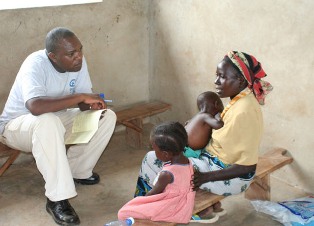
 |
| News & Outreach |
|
||||||
Global Health MattersJuly - August, 2008 | Volume 7, Issue 4
Malaria transmission rate change linked to kids' ages Nutrition counseling is a key part of malaria outreach. Photo: Wendy O'Meara For the first time, malaria transmission rates have been linked to the age of children seen in hospitals in rural coastal Kenya, where the disease has declined significantly in the past few years, new research led by a Fogarty scientist says. Dr. Wendy P. O'Meara and colleagues, including Fogarty senior scientist Dr. F. Ellis McKenzie, described efforts to draw public health conclusions about malaria in the Kilifi region of the country. "Data...show for the first time the direct relationship between changing transmission intensity and the mean age of clinical disease," they wrote in the American Journal of Tropical Medicine and Hygiene. They looked at longitudinal data from 16 years and suggested that the rise in mean age of hospital admissions for fever among children from 2.9 years to 4.9 years represented a better measure of changing transmission intensity than does incidence of disease. Previous studies have shown that as transmission increases, there is initially a large increase in hospital admissions but then the rate rises more slowly and may even plateau before decreasing slightly. O'Meara and colleagues said children show symptoms of malaria at younger ages where there is high transmission. In those areas, immunity to clinical illness from parasites develops in early childhood, but often older children and adults are infected without having any illness associated with their infection. Where there is very low transmission, the risk of clinical disease extends into adulthood, when it is more directly related to the risks of infection than the effect of acquired clinical immunity, O'Meara said. "Relationship Between Exposure, Clinical Malaria, and Age in an Area of Changing Transmission Intensity. Wendy P. O'Meara, Tabitha W. Mwangi, Thomas N. Williams, F. Ellis McKenzie, Robert W. Snow, and Kevin Marsh. Am. J. Trop. Med. Hyg., 79(2), 2008, pp. 185-191. Should you require Adobe Acrobat for viewing PDFs, current and free accessible plug-ins are available at the Adobe website.
|
|||||||
|